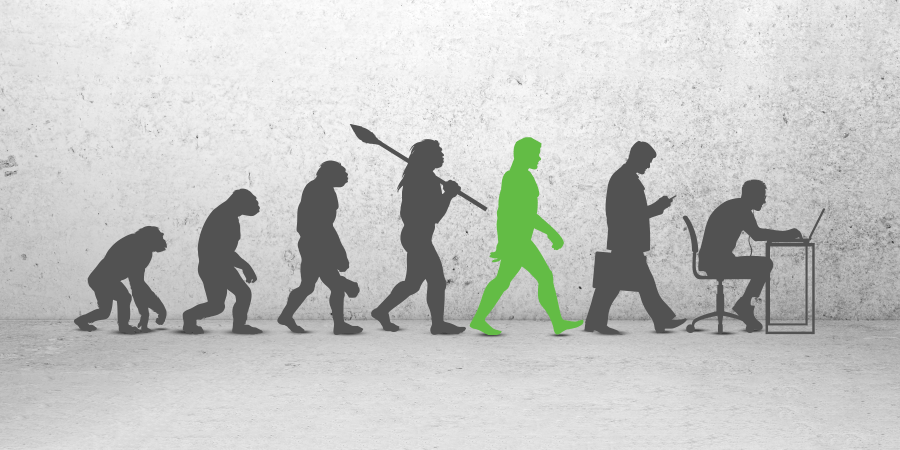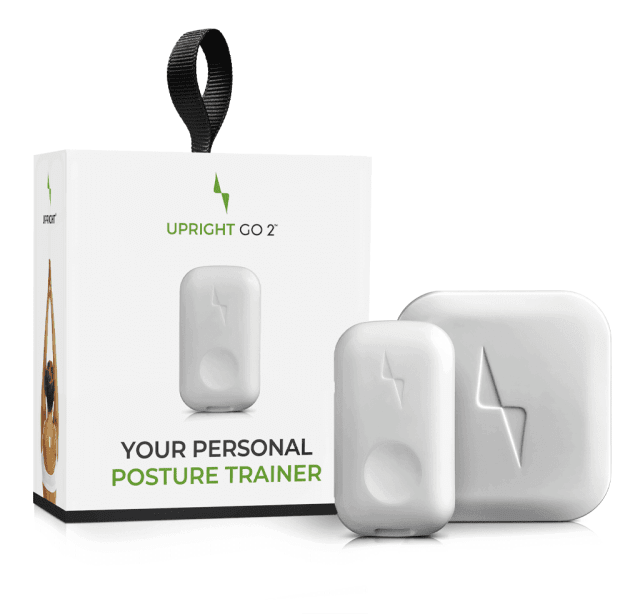How We Went from Troglodyte to Upright
Max Frenkel

Heard the one about the caveman who didn’t think humans could walk upright? He now stands corrected.
Along with developing a sense of humor, we humans have taken to bipedalism in a big way. Though we’re no longer hunting, gathering, or fending off predators as our ancestors once did, being upright has proven invaluable in asserting ourselves as the dominant species. Now, that doesn’t mean we should rest on our laurels; maintaining good posture is a lifelong pursuit, much like keeping fit and eating healthy. Just as our ancestors had to fashion tools to survive, we too need the right tools to build healthy habits that will ensure our continued success.
Add a smart posture trainer to your wellness toolkit.
The Downside of Being Upright
For all its many benefits, bipedalism is not without its challenges. As a species, we haven’t fully adapted to walking upright, which, by the way, is a lot harder to do than crawling around on all fours (we’re looking at you, distant ape cousins). Distributing all our weight on just two limbs puts a tremendous strain on our bodies and can lead to lower back pain, slipped disks, or worse. Add to that the fact that we’re constantly hunched over our computer screens and smartphones, and you’ve got yourself a recipe for terrible posture.
So, what can we do to keep from returning to our knuckle-dragging past?
Posture: Back in Time
Upright posture dates back millions of years, however, it only really entered the collective consciousness in the 1800s, when it became an indicator of social class and wealth. Back then, slouching or lounging was actually seen as a good thing, fashionable among the nobility who wanted to put their privilege on full display. This was in stark contrast to how soldiers were (and still are) trained to be perfectly upright as a way of enforcing discipline.
The notion that upright posture somehow made a person more virtuous carried through to the 1900s. Parents went to great lengths to ensure their children were standing and sitting up straight, thereby preventing their ‘moral decay’ – but more on that later. The 1960s flipped this idea on its head; people were no longer talking about posture with the same reverence. Once again, slouching was seen as a novelty and an act of rebellion.
Upright posture made a big comeback in the 2010s, with everyone from Tony Robbins to Amy Cuddy talking about how body position is affected by and, in turn, affects our mood. Adopting these so-called power poses enables us to project confidence, reduce injury, and improve brain function. Today, as we seek to live more mindfully, upright posture is seen as a key component – together with diet and exercise – to achieving peak wellness.
A Stern Reminder
To see how far we’ve come in terms of posture correction, we must look back at posture correctors of the past. And boy, were there some horrific-looking contraptions!
If you were ever scolded by a teacher for leaning back in your chair, spare a thought for the poor kids in early 1800s Germany who were forced to wear primitive head braces to prevent them from leaning forward in their chairs. This draconian measure was supposedly taken to protect their health and moral development, but I suspect it was really just to stop them from peeking at their classmates’ test papers.
Other forms of torture… sorry, posture correction from that era included iron corsets that would severely restrict the wearer’s movements, namely their ability to slouch. While this may have succeeded in keeping them upright, it must’ve made going to the bathroom quite an adventure. There was no respite for the people of the nineteenth century, even when seated. Three-legged corner chairs made it impossible to kick back with a brewski after a hard day down at the mines. Oh, the humanity!
Luckily, posture correctors have come a long way since the dark days of head braces and metal corsets. Today, you can get a posture trainer that’s no bigger than a box of Tic Tacs, light as a feather, and infinitely more comfortable to wear. Plus, using it doesn’t feel like a cruel and unusual punishment.
Tech to the Rescue!
Technology may be contributing to the current slouching epidemic, but it might also be its unlikely savior. Smart wearables such as the UPRIGHT GO 2 personal posture trainer transform the source of your ‘screen slouch’ (i.e., your smartphone) into a force for good. This ingenious little device works together with a free mobile app to help you retrain your brain, so sitting and standing upright becomes second nature. Best of all, you don’t have to wait millennia for evolution to take its course: when you train with the GO 2, you’ll start seeing results in as little as 14 days. Fred Flintstone, eat your heart out!
Isn’t it time you check your vertical privilege and get UPRIGHT?
You Might also Like
Search
Sign up to our newsletter
Follow Us On
Popular
Revisit the GO 2/S Device Setup
How to get started
Finding your upright position
How to find your target upright posture
Calibration
Check out the UPRIGHT GO 2

